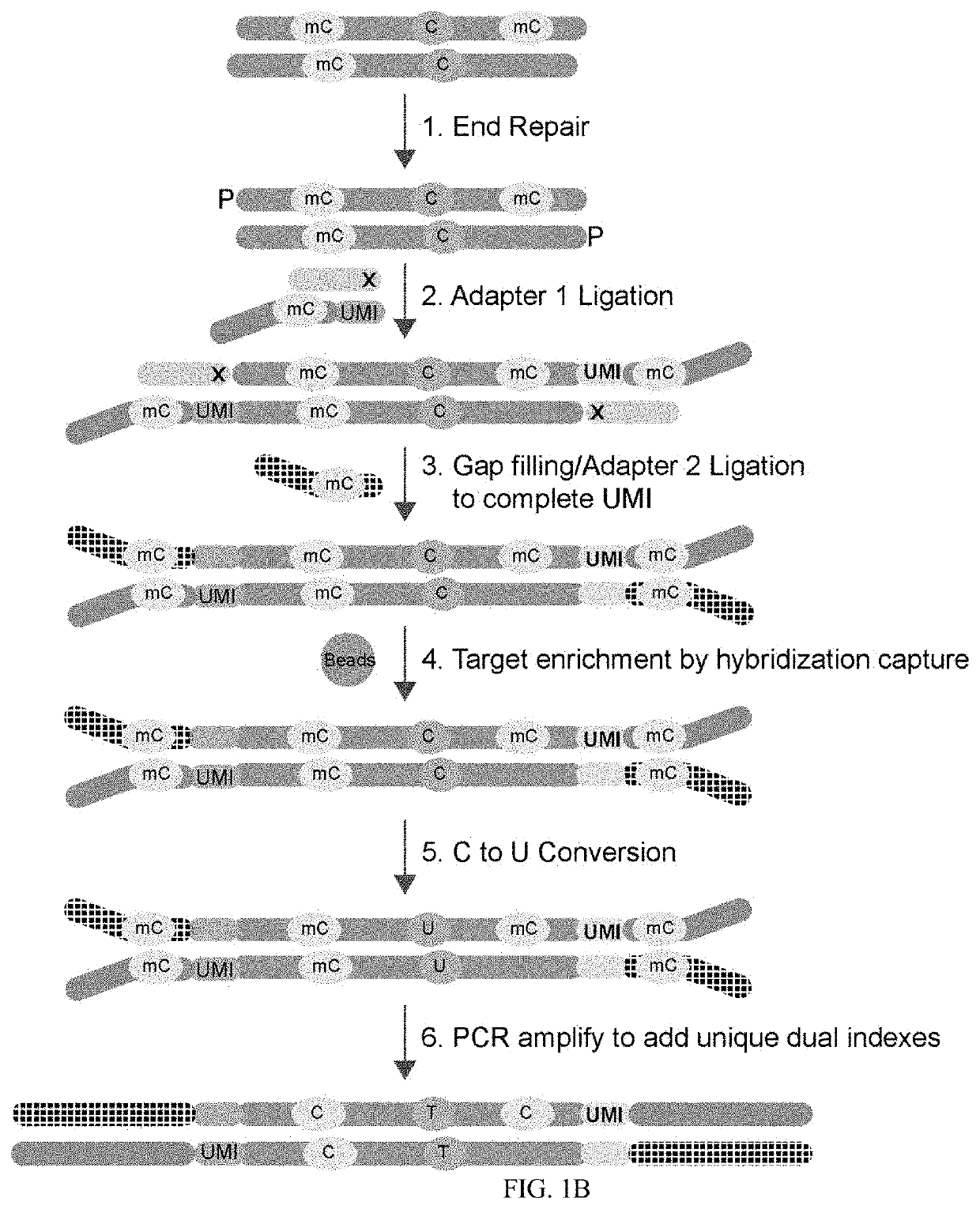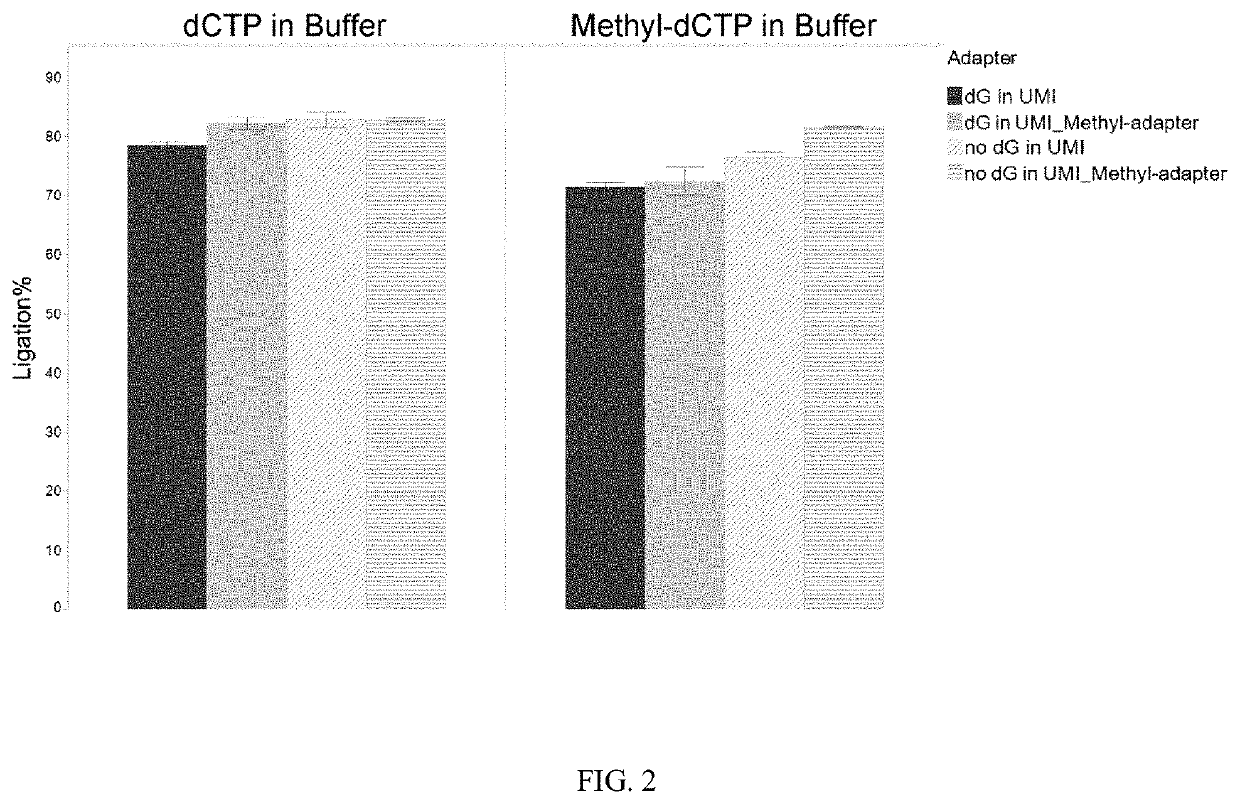Methods of Preparing Dual Indexed Methyl-Seq Libraries
a methyl-seq and library technology, applied in the field of methyl-seq library preparation, can solve the problems of affecting the results methylation-focused whole-genome deep sequencing has revealed rich complexity in cancer methylomes, and current methods do not provide users with the ability to use unique molecular identifiers (umis), so as to reduce amplification or sequencing and increase the accuracy of dna methylation analysis
- Summary
- Abstract
- Description
- Claims
- Application Information
AI Technical Summary
Benefits of technology
Problems solved by technology
Method used
Image
Examples
example 1
[0041]Whole Genome Methyl-Seq Library Construction
[0042]Target DNA is end repaired and prepared for blunt ligation. A mutant DNA ligase is used to attach 5′ adenylated and methylated adapters to the 3′ end of the target inserts. The complementary portion of the 5′ adapter is blocked to prevent ligation. A gap fill ligation is used to attach Adapter 2 and complementary UMI bases are filled in by TaqIT using a dNTP mix containing dATP, dTTP, dGTP, and methyl-dCTP. Unmethylated cytosine in the target nucleic acid are converted to uracil by bisulfite treatment or enzymatic treatment. PCR amplification of the UMI tagged target sequence is used to introduce unique dual indexes.
[0043]FIG. 1A demonstrates one embodiment of the workflow used to add UMI adapters to target nucleic acid, conversion of the unmethylated cytosine, and PCR amplification to add unique dual indexes and appropriate NGS platform specific adapter sequences. The prepared target sequence is then sequenced on the appropria...
example 2
[0046]Targeted Methyl-Seq Library Construction
[0047]DNA is end repaired and prepared for blunt ligation. A mutant DNA ligase is used to attached 5′ adenylated and methylated adapters to the 3′ end of the target inserts. The complementary portion of the 5′ adapter is blocked to prevent ligation. A gap fill ligation is used to attached Adapter 2 and complementary UMI bases are filled in by TaqIT using a dNTP mix containing dATP, dTTP, dGTP, and methyl-dCTP. Target regions are captured and enriched by hybridization capture methods. The hybridization capture panel utilizes a 2× alternating panel design for double stranded capture. (see FIG. 6). Following hybridization capture unmethylated cytosine in the target nucleic acid are converted to uracil by bisulfite treatment or enzymatic treatment. PCR amplification of the UMI tagged target sequence is used to introduce unique dual indexes.
[0048]FIG. 1B demonstrates one embodiment of the workflow used to add UMI adapters to target nucleic ac...
example 3
[0049]Detection of Methylation by WGBS Using Bisulfite Conversion of Unmethylated Cytosine
[0050]10 ng human genomic DNA (EpiScope Methylated HCT116 and NA12878) was mixed with 5% of unmethylated lambda DNA and sheared to 150 bp using the Covaris S2 instrument. EpiScope Methylated HCT116 gDNA is genomic DNA purified from human HCT116 cells that is highly methylated using CpG methylase (TaKaRa). Unmethylated lambda DNA was used to monitor the conversion efficiency of bisulfite treatment. Unmethylated cytosine were converted by EZ DNA methylation-Gold kit (Zymo). Libraries were sequenced on an Illumina MiSeq (2×150 base). Bisulfite sequencing data was analyzed by bismark program with default setting.
[0051]FIG. 3A demonstrates a 99.7% Cytosine to Uracil conversion rate and ˜80% unique mapping efficiency was obtained from both sample types. FIG. 3B shows that methylation levels for methylated HCT116 are 96.3%, 0.8%, and 0.5% in CpG, CHH and CHG contexts. Methylation levels for NA12878 ar...
PUM
| Property | Measurement | Unit |
|---|---|---|
| chromatic structure | aaaaa | aaaaa |
| chromatin stability | aaaaa | aaaaa |
| nucleic acid | aaaaa | aaaaa |
Abstract
Description
Claims
Application Information
 Login to View More
Login to View More - R&D
- Intellectual Property
- Life Sciences
- Materials
- Tech Scout
- Unparalleled Data Quality
- Higher Quality Content
- 60% Fewer Hallucinations
Browse by: Latest US Patents, China's latest patents, Technical Efficacy Thesaurus, Application Domain, Technology Topic, Popular Technical Reports.
© 2025 PatSnap. All rights reserved.Legal|Privacy policy|Modern Slavery Act Transparency Statement|Sitemap|About US| Contact US: help@patsnap.com



